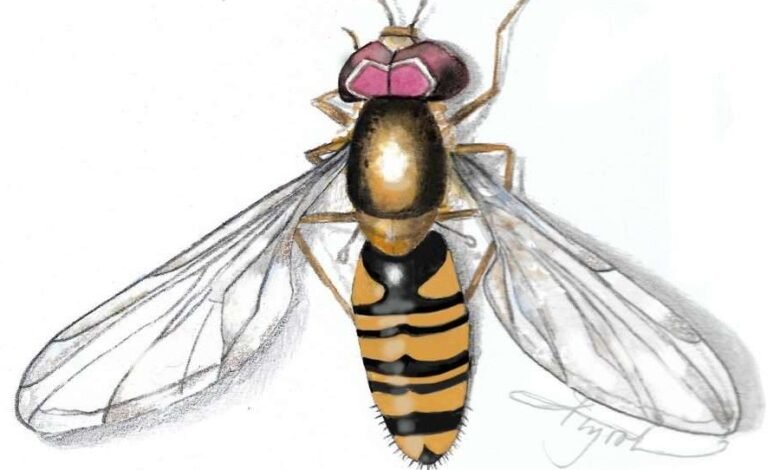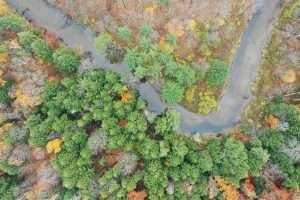Syrphid Flies Puzzle and Pollinate


 Survey the insects orbiting a globe of milkweed blossoms or the delicate blooms of a chokeberry, and you might spy an apparent chimera. It looks a bit like a bee, perhaps a tad like a wasp, and it darts and pauses mid-flight like a hummingbird.
Survey the insects orbiting a globe of milkweed blossoms or the delicate blooms of a chokeberry, and you might spy an apparent chimera. It looks a bit like a bee, perhaps a tad like a wasp, and it darts and pauses mid-flight like a hummingbird.
These diminutive helicopters are syrphid flies, so-called because they are members of the insect family Syrphidae.
Other common names for this family, which has an estimated 300 to 400 species in the Northeast, include hover flies and flower flies. They emerge in April or May and remain active through early October, foraging from early morning to early afternoon.
Even a keen-eyed observer might mistake a syrphid fly for a member of another insect family. Like bees and some wasps, adult syrphids can be found sipping nectar from the flowers of wild and cultivated plants.
Syrphid coloring – generally a combination of yellow, black, and brown shades in a pattern of stripes or dots – also mirrors these species, as do the tiny hairs some syrphids bear on their abdomens. Their characteristic hovering only enhances the masquerade.
Charlene Donahue, a retired entomologist with the Maine Forest Service, said that this behavior may serve several functions: as a component of male territorial displays, as a way for females to closely inspect suitable egg-laying sites, and as a foraging technique by both sexes to locate preferred flowers.
It’s no mere coincidence that syrphids look so much like these other buzzing insects. Syrphids benefit from an evolutionary strategy called Batesian mimicry, whereby species that would otherwise be tasty snacks resemble their less appetizing or potentially dangerous counterparts.
For syrphids, the likeness to bees and wasps deters would-be predators that avoid those species to steer clear of stings. The rub? Not a single species of syrphid fly in the Northeast – nor any of the more than 6,000 around the globe – can sting.
The Pollinator Partnership, an international non-profit organization that advocates for the protection of pollinators, highlights a few distinctions that can help you tell syrphid flies apart.
Syrphids have much larger eyes than bumblebees and wasps. They also have shorter antennae and skinnier legs. If you spot a syrphid fly at rest, their wings also offer a clue: like other “true flies” of the order Diptera, syrphids have just one set of wings (two wings total) compared to bees’ two sets (four wings total).
The distinctions extend beyond just looks. By some measures, syrphid flies outdo bees as pollinators. According to Margaret Skinner, an entomologist at University of Vermont Extension, syrphids “are considered particularly efficient at pollinating because they do not provision a nest like bees do and can range over a larger area of the landscape than other pollinators.”
Syrphids also fill critical ecosystem roles in other stages of their life cycle. The larvae of some species decompose plant matter. Others prey on soft-bodied insects, such as aphids. Adult female syrphids lay their eggs on leaf undersides near colonies of prey species.
Once hatched, a larva will feed for up to a month, molting three times before forming a puparium, a covering of hardened skin, from its exoskeleton. One to two weeks later, an adult syrphid fly emerges.
In the Northeast, syrphids can cycle through three to four generations per year. The last generation in the fall will overwinter either in puparia or as adults.
Thanks to this dimension of their ecology, syrphids are an ally to any gardener or farmer. Skinner noted that one syrphid fly larva “can feed on as many as 400 aphids over its lifetime.” Some syrphid species are even reared commercially as biological control agents for pest management.
Research from the University of New Hampshire, published in 2023 in the journal Environmental Entomology, indicates that bringing native plants, especially those in the Apiaceae family, such as golden alexander, and other native shrubs, like blueberry and blackberry, into your garden encourages greater populations of syrphids, which can reduce the need for pesticides.
Syrphids may not receive the same attention that bees do in our growing recognition of the importance of pollinators to our lives and ecosystems, but they certainly deserve it.
You can show your appreciation for these fascinating mimics by avoiding pesticides and rewilding your property with an abundance of native plants.
Learn more about insects in New York State.
Colby Galliher writes about conservation, ecology, and environmental policy. Hover fly illustration by Adelaide Murphy Tyrol. The Outside Story is assigned and edited by Northern Woodlands magazine and sponsored by the Wellborn Ecology Fund of New Hampshire Charitable Foundation: nhcf.org.
Source link




